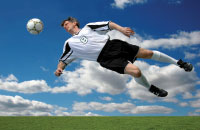
Overtraining Syndrome: Underlying causes of repetitive injury
By Scott Howitt DC FCCSS(C) FCCRS(C)
Features Clinical TechniquesThe bottom line in sports conditioning and fitness training is adaptive
body stress. Athletes must put their bodies under a certain amount of
stress to increase physical capabilities. Where the stress loads are
appropriate, then the athlete’s body adapts to the demands placed upon
it.
 The bottom line in sports conditioning and fitness training is adaptive body stress. Athletes must put their bodies under a certain amount of stress to increase physical capabilities. Where the stress loads are appropriate, then the athlete’s body adapts to the demands placed upon it. The adaptation to maximal loading of the cardiovascular and muscular systems is accomplished by improving efficiency of the heart, increasing capillaries in the muscles and increasing glycogen stores and mitochondrial enzyme systems within the muscle cells. In reality, hard training breaks athletes down and making them temporarily weaker, while it is rest that makes them stronger. Physiologic improvement in sports actually occurs during the rest period following hard training. During recovery periods, the cardiovascular and muscular systems build to greater levels to compensate, or rather overcompensate, for the stress applied during training. Overcompensation is the process that actually makes one a better athlete. During overcompensation, muscles stockpile higher-than-normal amounts of glycogen, synthesize greater-than-usual quantities of aerobic enzymes, add new proteins to muscles to make them stronger, etc. In other words, training stimulates rebound to a higher physiological state and the result is a higher level of performance.
The bottom line in sports conditioning and fitness training is adaptive body stress. Athletes must put their bodies under a certain amount of stress to increase physical capabilities. Where the stress loads are appropriate, then the athlete’s body adapts to the demands placed upon it. The adaptation to maximal loading of the cardiovascular and muscular systems is accomplished by improving efficiency of the heart, increasing capillaries in the muscles and increasing glycogen stores and mitochondrial enzyme systems within the muscle cells. In reality, hard training breaks athletes down and making them temporarily weaker, while it is rest that makes them stronger. Physiologic improvement in sports actually occurs during the rest period following hard training. During recovery periods, the cardiovascular and muscular systems build to greater levels to compensate, or rather overcompensate, for the stress applied during training. Overcompensation is the process that actually makes one a better athlete. During overcompensation, muscles stockpile higher-than-normal amounts of glycogen, synthesize greater-than-usual quantities of aerobic enzymes, add new proteins to muscles to make them stronger, etc. In other words, training stimulates rebound to a higher physiological state and the result is a higher level of performance.
CONSEQUENCES OF OVERTRAINING?
Overtraining can best be defined as the state where an athlete has been repeatedly stressed by training to the point where rest is no longer adequate to allow for recovery.
If sufficient rest is not included in a training program, then regeneration cannot occur and performance will actually plateau. If this imbalance between excess training and inadequate rest persists, then performance may even decline. The phenomenon is generally viewed on a continuum with overreaching at the lower end and overtraining syndrome at the more severe end of the fatigue scale.
This “overtraining syndrome” is the name given to the collection of emotional, behavioural and physical symptoms that result from overtraining and that persist for weeks to months. Athletes and coaches may also describe this as “burnout” or “staleness” or as a result of going “too hard, too fast, too often.” Overtraining is marked by cumulative exhaustion that persists even after recovery periods. It has been suggested that 10-20 per cent of athletes who train intensely experience overtraining that results in chronic decreases in performance and impaired ability to train.(1)
SIGNS AND SYMPTOMS OF OVERTRAINING
Overtraining is different from the day-to-day variation in performance and post-exercise tiredness – Delayed Onset Muscle Soreness – that is common in conditioned athletes. (As an aside, for those who strength train, researchers from McMaster University in Hamilton, Ontario and the Washington University School of Medicine in St. Louis suggest that the “repair and renew” process seems to peak about 24 hours after a workout, when the muscle protein synthesis rate is significantly increased. However, about 36 hours after a workout, the whole process is almost complete, and muscles are back to routine housekeeping. Although this time is somewhat variable, I suggest that my patients give at least 24-36 hours between bouts of intense exercise.)
The most common symptom seen clinically is fatigue, which is typically described as feeling “burnt out.” This feeling often cancels, or limits, workouts and may persist even at rest. The athlete can also become moody, easily irritated, have altered sleep patterns, become depressed, or lose the competitive desire and enthusiasm for his or her sport. Overtrained athletes generally present to sports injury practices with physical symptoms that include persistent muscular soreness, increased frequency of viral illnesses and most notably, increased incidence of injuries. Many injuries that result from overuse – for example, achilles tendonitis, shin splints, runner’s knee, ITB syndrome, rotator cuff tendonitis or swimmer’s shoulder – can be caused by too much volume or intensity of training. The body is simply unable to cope with the stresses of the training load and injuries result.
There have been many scientific studies performed on athletes with overreaching and overtraining syndrome. Although somewhat variable, the findings in these studies have described the following symptoms: decreased performance in exercise testing, decreased mood state and increased cortisol levels (stress hormone). A decrease in testosterone, altered immune status, and an increase in muscular break-down products has also been reported.(2)
| Common warning signs of overtraining include:
• Burnt-out feeling, overtiredness, feeling, lack of energy |
REVIEWING THE LITERATURE
A review of the scientific literature on overtraining reveals that there are two forms of the syndrome that are often described. The “sympathetic form” is more common in sprint-type sports while the “parasympathetic form” is more common in endurance sports. The specific results from the various measurements mentioned above, taken during exercise testing, differ between the two forms, but decreased overall performance and increased perceived fatigue remain consistent. In the parasympathetic form, there may actually be a lower heart rate for a given workload. Athletes training with specific heart-rate goals may notice that they cannot sustain the workout at their usual “set point.” Fatigue generally takes over and usually causes the athlete to prematurely terminate the workout. Regulation of glucose may also become altered and some athletes may experience symptoms of hypoglycemia during exercise.(2)
There is much controversy in the literature surrounding the exact laboratory results for overtraining and it is possible to have been diagnosed with overtraining syndrome, but have completely normal physical findings and biochemical tests. At this point, there is no single test that will absolutely confirm the presence of overtraining. Personally, I consider the diagnosis of overtraining syndrome, in any athlete who manifests symptoms of prolonged fatigue, recurrent or persistent muscular injuries and performance that has plateaued or decreased. Still, it is important to exclude any underlying illness that may be responsible for the fatigue.
TREATING OVERTRAINING SYNDROME
The treatment for overtraining syndrome is, quite simply, rest. The evidence suggests that the longer the overtraining has occurred, the more rest that is required. Therefore, the earlier in a sporting season that overtraining can be detected, the sooner the athlete will be able to return to competition.
If the overtraining – perhaps overreaching – has only occurred for a short period of time – i.e., less than a month – then interrupting training for three to five days is reported to provide sufficient rest. As training is resumed, it is recommended that workouts be scheduled on alternate days. The overall intensity of the training can be maintained, but the total volume of the work should be lower.
Identifying any problems in the training program, or additional life stressors, is important in that the factors that lead to overtraining need to be identified and corrected, or the overtraining syndrome is likely to recur. The alternate-day-workout recovery period is recommended for a few weeks, while monitoring symptoms, and, then, an increase in training volume can be permitted. In severe cases, or those where identifying the syndrome has been delayed, the training program may have to be interrupted for several weeks, and it may take months, or the better part of the season, to recover. An alternative form of exercise is sometimes substituted, to help prevent exercise withdrawal, but again, special attention needs to be paid to volume and intensity. Athletes should be reminded that resting from overtraining in one sport, while increasing training in another, may help a fatigued muscle, but will not have the same effect on the heart, pituitary and adrenals.
As with all athletic injuries, prevention is preferable to management. A training program that is properly scheduled with well-balanced gradual increases in training volume and intensity, and that takes into account the effect of each session, is recommended. Most coaches develop training schedules with a “periodisation design” which varies the training load in cycles with built-in mandatory rest phases.
USEFUL TRAINING TACTICS
Many coaches advocate keeping a training log as the best method to monitor progress. In addition to keeping track of distance and intensity of training, the athlete can record heart rate, weight, general health, how the workout felt and levels of muscular soreness and fatigue. A coach, or health professional, can use this information, as changes in any of these parameters may signal overtraining.
Most athletes agree that when it comes to competition, it is better to be undertrained than overtrained. Science tells us that rest can be as important as the actual physical training and that high intensity, lower volume can have a significant effect in improving performance. In fact, studies conducted at Ball State University in Muncie, Indiana, which looked at swimmers over the course of a season, showed that the athletes who made the greatest improvements were the ones who swam with the highest average intensity. In contrast, there was no relationship between training volume and performance improvement – that is, individuals who swam the greatest distances were not the ones with the biggest performance gains – and, similarly, there was no link between training frequency and performance upgrades. Swimming faster during training – but not longer or more frequently – was associated with significant upswings in performance.
Athletes, coaches and health practitioners should be aware of the early warning signs of overtraining and modify training accordingly as proper conditioning requires a balance between load and recovery.
References:
1. Raglin J, Barzdukas Overtraining in athletes: The challenge of prevention. ACSM. Health Fitness J. 3:27-31, 1999.
2. Halson, Shona,Jeukendrup, Asker. Does Overtraining Exist?: An Analysis of Overreaching and Overtraining Research. Sports Medicine. 34(14):967-981, 2004.
 Dr. Scott Howitt graduated from the CMCC and subsequently the two-year post-graduate residency in sports sciences. Most recently he completed his three-year post-graduate fellowship in Rehabilitative Sciences. Apart from his clinical work at Sports Performance Centres, and the Gorman Shore clinic at York University, Dr. Howitt is an assistant professor in the Clinical Sciences department of CMCC, as the Clinician for the St. John’s Rehab Hospital chiropractic clinic.
Dr. Scott Howitt graduated from the CMCC and subsequently the two-year post-graduate residency in sports sciences. Most recently he completed his three-year post-graduate fellowship in Rehabilitative Sciences. Apart from his clinical work at Sports Performance Centres, and the Gorman Shore clinic at York University, Dr. Howitt is an assistant professor in the Clinical Sciences department of CMCC, as the Clinician for the St. John’s Rehab Hospital chiropractic clinic.
Print this page